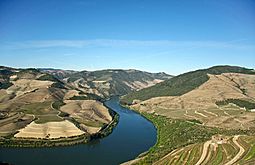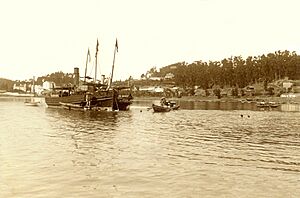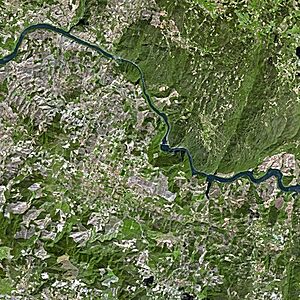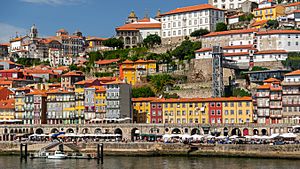Douro facts for kids
Quick facts for kids Douro |
|
|---|---|

The river flowing through the Portuguese wine region, designated as a World Heritage Site.
|
|
 |
|
| Other name(s) | Duero (Spanish) Douro (Portuguese) |
| Country | Spain, Portugal |
| Physical characteristics | |
| Main source | Picos de Urbión Sistema Ibérico, Duruelo de la Sierra, Soria, Castile and León, Spain 2,157 m (7,077 ft) 42°0′38″N 2°52′49″W / 42.01056°N 2.88028°W |
| River mouth | Foz do Douro Atlantic Ocean, Porto, Greater Porto, Norte, Portugal 0 m (0 ft) 41°8′36″N 8°40′10″W / 41.14333°N 8.66944°W |
| Length | 897 km (557 mi) |
| Discharge (location 2) |
|
| Basin features | |
| Basin size | 98,400 km2 (38,000 sq mi) |
| Tributaries | |
The Douro is a very important river in Spain and Portugal. It's known as the Duero in Spain. This river is the biggest in terms of water flow on the Iberian Peninsula. It starts high up in the mountains of Spain and flows west.
The Douro travels through the northern part of Spain and then into northern Portugal. It finally reaches the Atlantic Ocean near the city of Porto, which is the second-largest city in Portugal. Along its path, the river passes through beautiful landscapes. These areas are famous for producing port wine, a special kind of fortified wine.
Contents
What's in a Name?
The name Douro comes from the old Latin name Durius. This Latin name might have come from an even older Celtic word. Some people think the word *dubro- meant "water" in ancient Celtic languages.
There's also a fun story, a folk tale, that says the name means "golden" in Portuguese or Spanish. This is because the river's waters can sometimes look golden, especially at sunset.
A Journey Through History
Long ago, in Roman times, people even thought of the Douro River as a god! They called this river god Durius.
For many centuries, the Douro River was a natural border. It helped protect kingdoms from invaders. This made it a special place where different cultures and languages met.
The Douro Valley in Portugal is famous for its vineyards. These vineyards are so important that UNESCO has named the area a World Heritage Site. In the past, special flat-bottom boats called rabelos carried the wine down the river. They took it to cellars in Vila Nova de Gaia, right across from Porto. Today, big trucks do this job instead.
In the 1960s and 1970s, many dams were built on the river. These dams helped control the water flow and made it possible for boats to travel further upstream. They also produce hydroelectric power.
Where is the Douro River?
The Douro is about 897 kilometers (557 miles) long. This makes it the third-longest river on the Iberian Peninsula. Its entire river basin, which is the land area that drains into the river, covers about 97,290 square kilometers.
Douro in Spain
In Spain, the Douro flows through a large flat area called the Meseta Central. It passes through five different provinces in the region of Castile and León. Some of the towns it flows through include Soria, Almazán, Aranda de Duero, Tordesillas, and Zamora.
The land here is mostly dry plains. Farmers grow wheat and, in some areas like Ribera del Duero, they grow grapes for wine. Raising sheep is also an important activity in this region.
Douro on the Border
For about 112 kilometers (70 miles), the Douro River forms the border between Spain and Portugal. This part of the river flows through deep, narrow canyons. These canyons are so special that they are protected areas. On the Portuguese side, it's the International Douro Natural Park. On the Spanish side, it's the Arribes del Duero Natural Park.
Douro in Portugal
After leaving the border, the Douro flows entirely into Portugal. Here, you'll find fewer large towns right along the river. The main towns include Foz do Tua, Pinhão, and Peso da Régua. Finally, it reaches the big cities of Porto and Vila Nova de Gaia at the Atlantic Ocean.
Porto is a very important city in northern Portugal. Its old city center is a UNESCO World Heritage Site because of its amazing buildings and long history.
River Uses and Economy
The areas along the Douro River have a special climate. This climate is perfect for growing olives, almonds, and especially grapes. These grapes are essential for making the famous Port wine. The region around Pinhão is considered the heart of port wine production. Here, you'll see many quintas (farms or estates) with vineyards on the steep hillsides.
Today, many people enjoy taking tourist boat trips along the Douro River. These cruises go from Porto up into the beautiful Douro valley.
The Douro railway line was finished in 1887. It connects Porto with many towns along the river, making travel easier. Near the small city of Foz Côa, there's an important archaeological site. It's called the Côa Valley Paleolithic Art site, and it has ancient rock carvings. This site is also a UNESCO World Heritage Site.
Douro Dams
There are fifteen dams built on the Douro River. These dams help control the river's water flow. They also generate hydroelectric power, which is electricity made from moving water. The dams also have special locks that allow boats to travel up and down the river.
Five of the dams are in Spain, and five are along the border between Spain and Portugal. The last five dams are in Portugal. The highest lock, at the Carrapatelo Dam, can lift boats up to 35 meters (115 feet)! This allows ships to navigate far inland.
Gallery
-
The Pisuerga River (tributary to the Duero) in Valladolid
-
The Upper Douro valley where Port wine grapes grow
-
The typical rabelo boat and Porto historical district in background
-
Port wine signs by the Douro River
-
Panoramic view of Oporto
-
The river between Porto and Vila Nova de Gaia
-
The river mouth in Porto
See also
 In Spanish: Duero para niños
In Spanish: Duero para niños


















